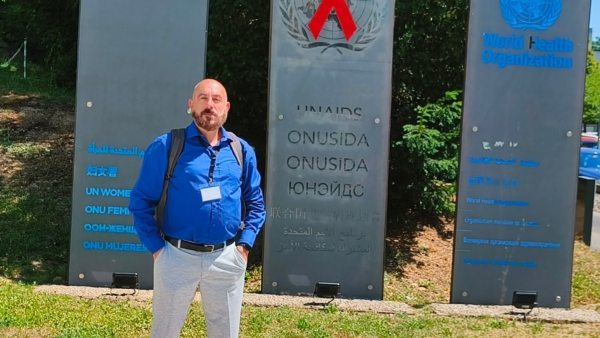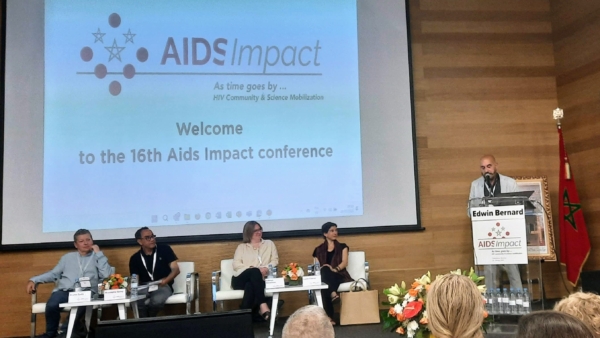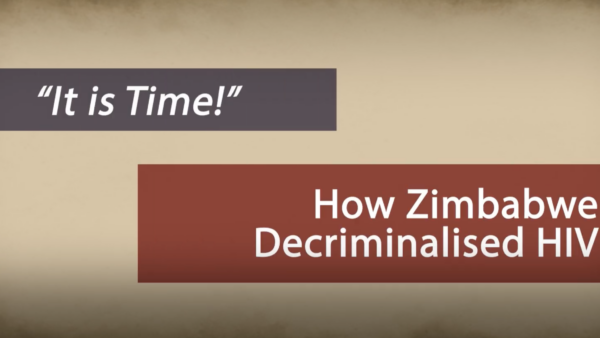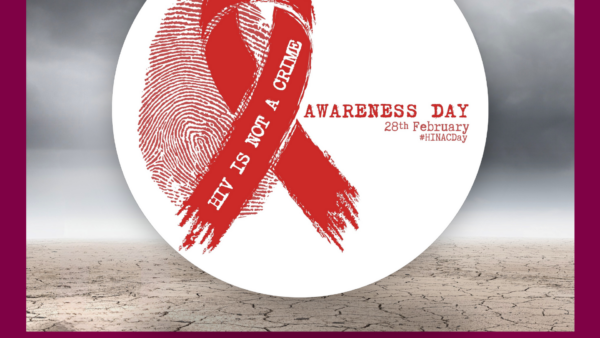
DREDF HIV Criminalization Statement
Disability Rights Education & Defense Fund (DREDF) opposes the criminalization of people based on their HIV-positive status. In addition to being harmful to public health, laws and prosecution targeting HIV-positive people constitute discrimination on the basis of disability. The Americans with Disabilities Act (ADA)[1] prohibits disability discrimination by state and local governments.[2] State laws and prosecutions that criminalize people living with HIV without a basis in current objective medical and scientific knowledge violate the ADA and other antidiscrimination mandates. We urge lawmakers across the country to modernize their HIV laws and policies, and to discard outdated and harmful punitive approaches.
Background
During the outset of the HIV epidemic, many states enacted laws that criminalized or enhanced the criminal penalties for certain acts by people living with HIV that were thought to create the risk of exposure to HIV.[3] These laws were passed at a time when fear and misinformation about HIV was widespread, particularly about how HIV is transmitted. Today, with the benefit of more than 30 years of research and considerable advances in medical treatments, the scientific and medical communities have learned much more about how HIV is transmitted and how to prevent transmission. We now know that HIV is not spread through saliva, tears, or sweat.[4] We also know that the use of condoms, PrEP (pre-exposure prophylaxis), and antiviral medication, by themselves or in combination, can dramatically reduce the risk of HIV transmission, in some cases to zero.[5] HIV has also become a medical condition that is managed with medications and other treatments, with people with HIV now having a life expectancy that matches that of the general public.[6] Yet most HIV criminal laws do not reflect current scientific and medical knowledge.[7] In addition, HIV criminalization laws undermine public health by discouraging people from seeking testing and treatment options, such as antiviral medication, that can protect their health and reduce transmission.[8]
Outdated HIV criminalization laws constitute disability discrimination because they treat people living with HIV more harshly without an objective scientific basis. Several states, such as California, Missouri, and North Carolina, have taken steps in recent years to modernize their state HIV laws.[9] Unfortunately, many state laws have still not been updated to reflect current scientific and medical knowledge. Laws in several states criminalize acts that cannot transmit HIV, such as spitting,[10] or that pose no material risk of transmission.[11] These laws do not account for actions that reduce risk, such as condom usage or PrEP or whether transmission has actually occurred.[12]
People with disabilities, including people living with HIV, deserve to live lives free from discrimination and irrational prejudice. DREDF opposes outdated laws that single out people for criminal penalties or enhanced criminal penalties based on their HIV-positive status. These laws violate the ADA and undermine public health. They should be repealed.
[1] 42 U.S.C. § 12131 et seq.
[2] 42 U.S.C. § 12132.
[3] See J. Kelly Strader, Criminalization as a Policy Response to a Public Health Crisis, 27 J. Marshall L. Rev. 435 (1994); Wendy E. Permet, AIDS and Quarantine: The Revival of an Archaic Doctrine, 14 Hofstra L. Rev. 53 (1985-1986).
[4] Centers for Disease Control and Prevention, Ways HIV is Not Transmitted, (April 21, 2021) available at https://www.cdc.gov/hiv/basics/hiv-transmission/not-transmitted.html (“[HIV] is not transmitted […] Through saliva, tears, or sweat”).
[5] Robert W. Eisinger, Carl W. Dieffenbach, Anthony S. Fauci, HIV Viral Load and Transmissibility of HIV Infection: Undetectable Equals Untransmittable, Journal of the American Medical Association (2019), available at https://jamanetwork.com/journals/jama/article-abstract/2720997; National Institute of Allergy and Infectious Disease, The Science Is Clear—With HIV, Undetectable Equals Untransmittable: NIH Officials Discuss Scientific Evidence and Principles Underlying the U=U Concept, (Jan. 10 2019), available at https://www.niaid.nih.gov/news-events/science-clear-hiv-undetectable-equals-untransmittable (“In recent years, an overwhelming body of clinical evidence has firmly established the HIV Undetectable = Untransmittable (U=U) concept as scientifically sound, say officials from the National Institutes of Health. U=U means that people living with HIV who achieve and maintain an undetectable viral load—the amount of HIV in the blood—by taking and adhering to antiretroviral therapy (ART) as prescribed cannot sexually transmit the virus to others.”); Alison J. Rodger, Valentina Cambiano, Tina Bruun, et al., Sexual Activity Without Condoms and Risk of HIV Transmission in Serodifferent Couples When the HIV-Positive Partner Is Using Suppressive Antiretroviral Therapy, JAMA. 2016;316(2):171-181. doi:10.1001/jama.2016.5148 (2016), available at https://jamanetwork.com/journals/jama/fullarticle/2533066; Roger Chou, Christopher Evans, Adam Hoverman, et al., Preexposure Prophylaxis for the Prevention of HIV Infection: Evidence Report and Systematic Review for the US Preventive Services Task Force, JAMA (2019), available at https://jamanetwork.com/journals/jama/fullarticle/2735508; Centers for Disease Control and Prevention, PrEP Effectiveness (May 13, 2021), available at https://www.cdc.gov/hiv/basics/prep/prep-effectiveness.html (“PrEP reduces the risk of getting HIV from sex by about 99% when taken as prescribed.”).
[6] Hasina Samji, et al., Closing the Gap: Increases in Life Expectancy among Treated HIV-Positive Individuals in the United States and Canada (December 18, 2013), PLOS ONE, available at https://doi.org/10.1371/journal.pone.0081355.
[7] Division of HIV Prevention, National Center for HIV, Viral Hepatitis, STD, and TB Prevention – Centers for Disease Control and Prevention, HIV Criminalization and Ending the HIV Epidemic in the U.S., available at https://www.cdc.gov/hiv/policies/law/criminalization-ehe.html (“After more than 30 years of HIV research and significant biomedical advancements to treat and prevent HIV, most HIV criminalization laws do not reflect current scientific and medical evidence.”).
[8] Division of HIV Prevention, National Center for HIV, Viral Hepatitis, STD, and TB Prevention – Centers for Disease Control and Prevention, HIV Criminalization and Ending the HIV Epidemic in the U.S., available at https://www.cdc.gov/hiv/policies/law/criminalization-ehe.html (“[HIV criminalization] laws have not increased disclosure and may discourage HIV testing, increase stigma against people with HIV, and exacerbate disparities.”); J. Stan Lehman et al., Prevalence and Public Health Implications of State Laws that Criminalize Potential HIV Exposure in the United States, AIDS Behav. 2014; 18(6): 997–1006., available at https://www.ncbi.nlm.nih.gov/pmc/articles/PMC4019819/.
[9] Division of HIV Prevention, National Center for HIV, Viral Hepatitis, STD, and TB Prevention – Centers for Disease Control and Prevention, HIV and STD Criminalization Laws, available at https://www.cdc.gov/hiv/policies/law/states/exposure.html.
[10] See, e.g., MISS. CODE ANN. § 97-27-14(2); Ind. Code §§ 35-42-2-1, 35-45-16-2(c), 35-50-3-3; OHIO REV. CODE ANN. §§ 2921.38, 2929.14.; 18 PA. CONS. STAT. ANN. § 2703.
[11] See ALA. CODE § 22-11A-21; ARK. CODE ANN. § 5-14-123; Centers for Disease Control and Prevention, Ways HIV Can Be Transmitted, (April 21, 2021) available at https://www.cdc.gov/hiv/basics/hiv-transmission/ways-people-get-hiv.html (“[t]here is little to no risk of getting HIV” from oral sex); Julie Fox, Peter J. White, Jonathan Weber, et al., Quantifying Sexual Exposure to HIV Within an HIV-Serodiscordant Relationship: Development of an Algorithm, AIDS 2011, 25:1065–1082 at 1077 (2011).
[12] J. Stan Lehman et al., Prevalence and Public Health Implications of State Laws that Criminalize Potential HIV Exposure in the United States, AIDS Behav. 2014; 18(6): 997–1006., available at https://www.ncbi.nlm.nih.gov/pmc/articles/PMC4019819/.







